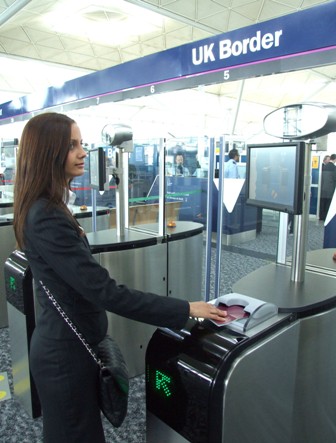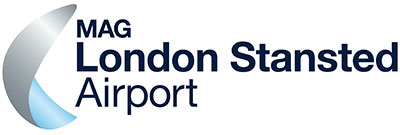The new machines, which scan passengers' faces and check them against their passport photo, are being trialled at the airport to improve border security and cut queues at arrivals.
The trial has been running at Stansted since December and has so far been used by nearly 160,000 passengers. The trial has been extended until October meaning the gates will be in use at Stansted throughout the busy holiday season. Barry McGill, Assistant Director for the UK Border Agency at Stansted Airport, said: "My message to passengers travelling through Stansted is simple. If you hold one of the new biometric passports, please take advantage of these gates and help to reduce the time you spend at passport control. You don’t need to register. All you need is a biometric passport issued since 2006. “Britain's border security is amongst the toughest in the world.
“By using new technology we are helping make our border even more secure, making the UK safer, speeding up travel for passengers and improving our service to the public. "Every gate is supervised at all times by a UK Border Agency officer, and this trial gives our officers an extra tool to improve security at the border.” The trial at Stansted is being run in partnership between the UK Border Agency and airport operator BAA. Neale Jouques, Stansted Airport’s Head of Terminal, said: “Here at Stansted, we have invested heavily in the arrivals experience for our passengers. In addition to the £50 million extension to the arrivals hall and increase to the number of desks available to UK Border Agency, we have been delighted to install these new automated machines. “We have also provided additional BAA staff to assist with the introduction of the new equipment and help raise awareness of the trial. "The new facial recognition gates have been very well received by our passengers, with their feedback overwhelmingly positive. They provide an additional option at immigration control for those travelling with a biometric passport, help improve border security while also reducing queuing times for arriving passengers.” The facial recognition gates work by using scanners to compare the faces of passengers to their biometric passports.
The system measures points on a person's face and compares them with the digital passport photograph. People who have changed their appearance since their passport pictures were taken will not pose problems, because the system will still be able to compare them accurately.
The gates undertake checks against security watch-lists in the same way as the current manual control – checking the passports for evidence of tampering and making sure the passenger matches the passport.
UK Border Agency officers continue to oversee the gates and intervene if they have any suspicions about any passengers. Passengers will also be subject to random manual checks. The gates allow officers extra time to concentrate on high-priority risks and intelligence-led operations. The facial recognition system is voluntary and can be used by any UK or European passenger carrying a new biometric passport. No registration is required to use the gates. Nearly 17 million biometric passports, which contain images, fingerprints or iris patterns, have been issued in the UK since their introduction in 2006.
The facial recognition trial at Stansted and a similar one being run at Manchester Airport are part of the biggest shake-up in UK border security for 40 years. Every visa applicant is fingerprinted and checked against a range of immigration, crime and terrorism watch-lists before they set foot in the UK, while the ongoing roll-out of ID cards for foreign nationals locks those here to one identity. The new £1.2bn e-Borders system is helping the UK Border Agency target terrorist suspects, known criminals and would-be illegal immigrants before they can reach the UK.
e-Borders will enable the Agency to count people in and out of the country with 60 per cent of all passenger and crew movements captured by December 2009, 95 per cent by December 2010 and all passengers by 2014.











